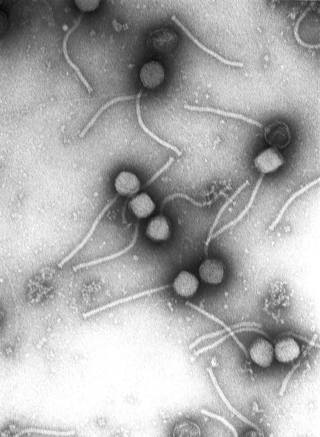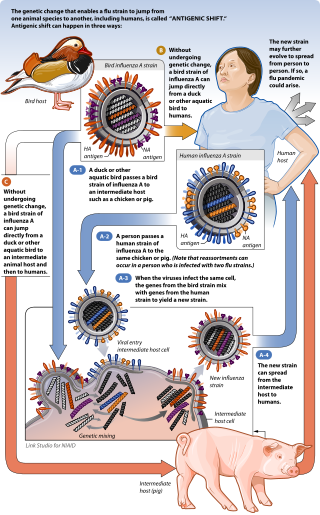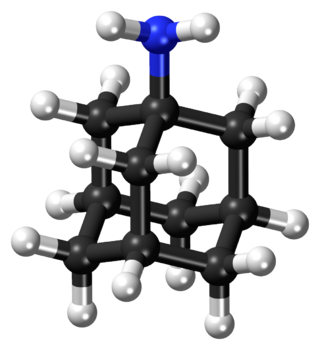Related Research Articles

Virology is the scientific study of biological viruses. It is a subfield of microbiology that focuses on their detection, structure, classification and evolution, their methods of infection and exploitation of host cells for reproduction, their interaction with host organism physiology and immunity, the diseases they cause, the techniques to isolate and culture them, and their use in research and therapy.

Antigenic shift is the process by which two or more different strains of a virus, or strains of two or more different viruses, combine to form a new subtype having a mixture of the surface antigens of the two or more original strains. The term is often applied specifically to influenza, as that is the best-known example, but the process is also known to occur with other viruses, such as visna virus in sheep. Antigenic shift is a specific case of reassortment or viral shift that confers a phenotypic change.

Rimantadine is an orally administered antiviral drug used to treat, and in rare cases prevent, influenzavirus A infection. When taken within one to two days of developing symptoms, rimantadine can shorten the duration and moderate the severity of influenza. Rimantadine can mitigate symptoms, including fever. Both rimantadine and the similar drug amantadine are derivates of adamantane. Rimantadine is found to be more effective than amantadine because when used the patient displays fewer symptoms. Rimantadine was approved by the Food and Drug Administration (FDA) in 1994.

Amantadine, sold under the brand name Gocovri among others, is a medication used to treat dyskinesia associated with parkinsonism and influenza caused by type A influenzavirus, though its use for the latter is no longer recommended because of widespread drug resistance. It is also used for a variety of other uses. The drug is taken by mouth.
Viral pneumonia is a pneumonia caused by a virus. Pneumonia is an infection that causes inflammation in one or both of the lungs. The pulmonary alveoli fill with fluid or pus making it difficult to breathe. Pneumonia can be caused by bacteria, viruses, fungi or parasites. Viruses are the most common cause of pneumonia in children, while in adults bacteria are a more common cause.

Influenza, commonly known as the flu, is an infectious disease caused by influenza viruses. Symptoms range from mild to severe and often include fever, runny nose, sore throat, muscle pain, headache, coughing, and fatigue. These symptoms begin one to four days after exposure to the virus and last for about two to eight days. Diarrhea and vomiting can occur, particularly in children. Influenza may progress to pneumonia from the virus or a subsequent bacterial infection. Other complications include acute respiratory distress syndrome, meningitis, encephalitis, and worsening of pre-existing health problems such as asthma and cardiovascular disease.

Betacoronavirus cameli, or EMC/2012 (HCoV-EMC/2012), is the virus that causes Middle East respiratory syndrome (MERS). It is a species of coronavirus which infects humans, bats, and camels. The infecting virus is an enveloped, positive-sense, single-stranded RNA virus which enters its host cell by binding to the DPP4 receptor. The species is a member of the genus Betacoronavirus and subgenus Merbecovirus.

Middle East respiratory syndrome (MERS) is a viral respiratory infection caused by Middle East respiratory syndrome–related coronavirus (MERS-CoV). Symptoms may range from none, to mild, to severe depending on age and risk level. Typical symptoms include fever, cough, diarrhea, and shortness of breath. The disease is typically more severe in those with other health problems.
London1_novel CoV/2012 is a coronavirus strain isolated from a Qatari man in London in 2012 who was one of the first patients to come down with what has since been named Middle East respiratory syndrome-related coronavirus (MERS-CoV). The Qatari patient had traveled to Saudi Arabia from Qatar. He returned to Qatar, but when he fell ill, he traveled to London for treatment. The United Kingdom's Health Protection Agency (HPA) named the virus.

Wendy Sue Fox is a British virologist. She is currently head of Department of Infectious Disease and chair in Influenza Virology at Imperial College London. She leads a team of scientists studying the influenza virus and its physiology and morphology to discover novel vaccines. In particular, they are trying to understand more about influenza virus mutations, and how they can allow scientists to create new vaccines against possible flu pandemics.

Dame Sarah Catherine Gilbert FRS is an English vaccinologist who is a Professor of Vaccinology at the University of Oxford and co-founder of Vaccitech. She specialises in the development of vaccines against influenza and emerging viral pathogens. She led the development and testing of the universal flu vaccine, which underwent clinical trials in 2011.

COVID-19 testing involves analyzing samples to assess the current or past presence of SARS-CoV-2, the virus that cases COVID-19 and is responsible for the COVID-19 pandemic. The two main types of tests detect either the presence of the virus or antibodies produced in response to infection. Molecular tests for viral presence through its molecular components are used to diagnose individual cases and to allow public health authorities to trace and contain outbreaks. Antibody tests instead show whether someone once had the disease. They are less useful for diagnosing current infections because antibodies may not develop for weeks after infection. It is used to assess disease prevalence, which aids the estimation of the infection fatality rate.

Christian Heinrich Maria Drosten is a German virologist whose research focus is on novel viruses (emergent viruses). During the COVID-19 pandemic, Drosten came to national prominence as an expert on the implications and actions required to combat the illness in Germany.
Maria DeJoseph Van Kerkhove is an American infectious disease epidemiologist. With a background in high-threat pathogens, Van Kerkhove specializes in emerging and re-emerging infectious diseases and is based in the Health Emergencies Program at the World Health Organization (WHO). She is the technical lead of COVID-19 response and the head of emerging diseases and zoonosis unit at WHO.

Kizzmekia "Kizzy" Shanta Corbett is an American viral immunologist. She is an Assistant Professor of Immunology and Infectious Diseases at Harvard T.H. Chan School of Public Health and the Shutzer Assistant Professor at the Harvard Radcliffe Institute since June 2021.

Sandra Ciesek is a German physician and virologist. She is the director of the Institute of Medical Virology at the Universitätsklinikum Frankfurt and professor of medical virology at the Goethe University Frankfurt. Her main areas of research include new forms of therapy for hepatitis C and, more recently, the search for drugs against COVID-19.
Human-to-human transmission (HHT) is an epidemiologic vector, especially in case the disease is borne by individuals known as superspreaders. In these cases, the basic reproduction number of the virus, which is the average number of additional people that a single case will infect without any preventative measures, can be as high as 203.9. Interhuman transmission is a synonym for HHT.
Isabella Eckerle is a German virologist who is the co-Head of the Centre for Emerging Viral Diseases at the Geneva University Hospitals and the University of Geneva. Her research considers infectious diseases and the development of cell lines that allow a better understanding of their epidemiology. During the COVID-19 pandemic, Eckerle studied the difference in response of adults and children to coronavirus disease.
Viral interference, also known as superinfection resistance, is the inhibition of viral reproduction caused by previous exposure of cells to another virus. The exact mechanism for viral interference is unknown. Factors that have been implicated are the generation of interferons by infected cells, and the occupation or down-modulation of cellular receptors.
Vaccine-associated enhanced respiratory disease (VAERD), or simply enhanced respiratory disease (ERD), is an adverse event where an exacerbated course of respiratory disease occurs with higher incidence in the vaccinated population than in the control group. It is a barrier against vaccine development that can lead to its failure.
References
- 1 2 Her thesis on 1 -aminoadamantane (also named amantadine) can be downloaded by using a link associated to the thesis' title in her Google Scholar profile.
- ↑ "Zambon, Maria C." SCOPUS. Retrieved 14 June 2021.
h-index:75
- 1 2 "Maria Zambon, Public Health England, UK". ISIRV. Retrieved 25 April 2020.
- ↑ Sugrue, R. J.; Bahadur, G.; Zambon, M. C.; Hall-Smith, M.; Douglas, A. R.; Hay, A. J. (1990). "Specific structural alteration of the influenza haemagglutinin by amantadine". The EMBO Journal. 9 (11): 3469–3476. doi:10.1002/j.1460-2075.1990.tb07555.x. PMC 552095 . PMID 2209554.
- ↑ Sample, Ian (24 April 2020). "Who's who on secret scientific group advising UK government?". The Guardian. Retrieved 24 April 2020.
- ↑ De Groot, Raoul J.; Baker, Susan C.; Baric, Ralph S.; Brown, Caroline S.; Drosten, Christian; Enjuanes, Luis; Fouchier, Ron A. M.; Galiano, Monica; Gorbalenya, Alexander E.; Memish, Ziad A.; Perlman, Stanley; Poon, Leo L. M.; Snijder, Eric J.; Stephens, Gwen M.; Woo, Patrick C. Y.; Zaki, Ali M.; Zambon, Maria; Ziebuhr, John (2013). "Commentary: Middle East Respiratory Syndrome Coronavirus (MERS-CoV): Announcement of the Coronavirus Study Group". Journal of Virology. 87 (14): 7790–7792. doi:10.1128/JVI.01244-13. PMC 3700179 . PMID 23678167.
- ↑ Corman, Victor M.; Landt, Olfert; Kaiser, Marco; Molenkamp, Richard; Meijer, Adam; Chu, Daniel KW; Bleicker, Tobias; Brünink, Sebastian; Schneider, Julia; Schmidt, Marie Luisa; Mulders, Daphne GJC; Haagmans, Bart L.; Van Der Veer, Bas; Van Den Brink, Sharon; Wijsman, Lisa; Goderski, Gabriel; Romette, Jean-Louis; Ellis, Joanna; Zambon, Maria; Peiris, Malik; Goossens, Herman; Reusken, Chantal; Koopmans, Marion PG; Drosten, Christian (2020). "Detection of 2019 novel coronavirus (2019-nCoV) by real-time RT-PCR". Eurosurveillance. 25 (3). doi:10.2807/1560-7917.ES.2020.25.3.2000045. hdl: 10067/1665670151162165141 . PMC 6988269 . PMID 31992387 . Retrieved 14 June 2021. (This paper currently has an expression of concern, see doi:10.2807/1560-7917.ES.2020.25.48.2012031, PMID 33272356, Retraction Watch )
- ↑ "Diagnostic detection of 2019-nCoV by real-time RT-PCR" (PDF). WHO. 17 January 2020. Retrieved 14 June 2021.
- ↑ "Professor Maria Zambon FMedSci". Academy of Medical Sciences. Retrieved 25 April 2020.
- ↑ "National Infection Service - latest information regarding 2019-nCoV coronavirus". Royal College of Pathologists. 7 February 2020. Retrieved 25 April 2020.
Professor Maria Zambon BSc BMBCh PhD FRCPath FMedSci